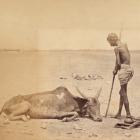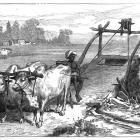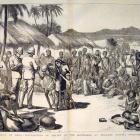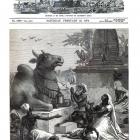About the exhibition
Between 1850 and 1899, India suffered 24 major famines, a number higher than in any other recorded 50-year period, resulting in millions of deaths. This exhibition describes the environmental and social factors that contributed to these cataclysmic events, situating their causes and costs within the complex natural and cultural contexts of nineteenth-century colonial India.
The deadly impacts of the famines were in many ways exacerbated by policies of British colonial rule. For instance, commercialized agriculture and landlordism removed local control over harvests. This eliminated the practice of balancing out lean years with stored food from past harvests, as had been done under the earlier system of subsistence farming. India’s infrastructure developed rapidly in the late nineteenth century, especially in the form of railroad networks. But these developments were aimed at transporting crops for export, not feeding local populations, and therefore did not prevent mass starvation. Finally, British relief efforts were frequently inadequate to meet the huge challenge of famine relief.
Indian famines in the nineteenth century attest to the complexity of humans’ interactions with the natural world. For example, while it is not surprising that food shortages were exacerbated by the transition to commercialized agriculture under colonial rule, the fact that British forestry law also led to starvation is less obvious. While the colonial rulers might have thought that they were simply restricting forest access in order to protect timber resources, these rules in fact cut off natives’ access to forest ecosystems that had previously served as a buffer zone when agricultural crops failed. Further, in hindsight, it is evident that a railroad system designed only to take food away from rural areas would be a problem, given that the rural farming communities were frequently plagued by famine. It is more surprising, however, to note the ways in which these railroads also served to transport disease, thus contributing to malaria outbreaks, which were most severe once the food shortage had ended, rains had fallen, and crops had recovered. In fact, these epidemics—only indirectly caused by the famines—proved more deadly than the starvation directly caused by food shortages.
Considering political, social, economic, and environmental factors of famines in nineteenth-century India, this exhibition gives a brief introduction to these complex and catastrophic events.
About the authors
Naresh Chandra Sourabh is professor and founder Director at the Institute of Social Research and Development, Patna, India. He received his M.A. degree in Sociology from Jawaharlal Nehru University, New Delhi, in 1982 and his Ph.D. also in Sociology from the University of Helsinki in 2008. He is the author of the socio-ethnographic work The Culture of Women’s Housework. Previously, Dr. Sourabh lectured “Food in Indian History- Production, Consumption and Culture from the Colonial Times to the Present” at Turku University, where he was a fellow with the project Finnish Harvest Failures and Famines in the International Context, funded by the Academy of Finland.
Timo Myllyntaus is Professor of Finnish history at Turku University. He earned his first two degrees at Helsinki University and a Ph.D. in economic history at the London School of Economics. His research interests stretch from economic and social history to environmental history. His edited volumes include Thinking through the Environment: Green Approaches to Global History (2011) and Invisible Bicycle. New Insights in Bicycle History (co-edited with Tiina Männistö-Funk, forthcoming in 2016). He has also published around one hundred scientific articles and fifty popular articles. Myllyntaus has directed more than a dozen research projects, participated in activities of various scientific organizations including the European Society for Environmental History, and acted as a peer-reviewer for several journals.
Acknowledgements
Support for the virtual exhibition was provided by the Rachel Carson Center for Environment, the Climates of Migration Project, and Society and Turku University, Finland. The exhibition draws on the work of the research project Finnish Harvest Failures and Famines in the International Context, Long-term Comparison of Economic and Environmental Margins, funded by the Academy of Finland (project code #259881) and directed by Professor of Finnish History Timo Myllyntaus. Aleksi Lahdenmaa, Pauliina Myllyntaus, and staff of the Rachel Carson Center assisted with the exhibition’s production. Smt. Kanchan Raj provided research assistance. Thanks to the staffs of the library of Abo Academy University, the library of Turku University, and National Library of Finland for their patience and support. The Institute of Social Research and Development (ISRD), Patna, Bihar provided the facility for Prof. Sourabh’s work.
How to cite
Sourabh, Naresh Chandra and Timo Myllyntaus. “Famines in Late Nineteenth-Century India: Politics, Culture, and Environmental Justice.” Environment & Society Portal, Virtual Exhibitions 2015, no. 2. Rachel Carson Center for Environment and Society. doi.org/10.5282/rcc/6812.
ISSN 2198-7696 Environment & Society Portal, Virtual Exhibitions
 2015 Naresh Chandra Sourabh and Timo Myllyntaus
2015 Naresh Chandra Sourabh and Timo Myllyntaus
This refers only to the text and does not include any image rights.
Please click on an image to view its individual rights status.















